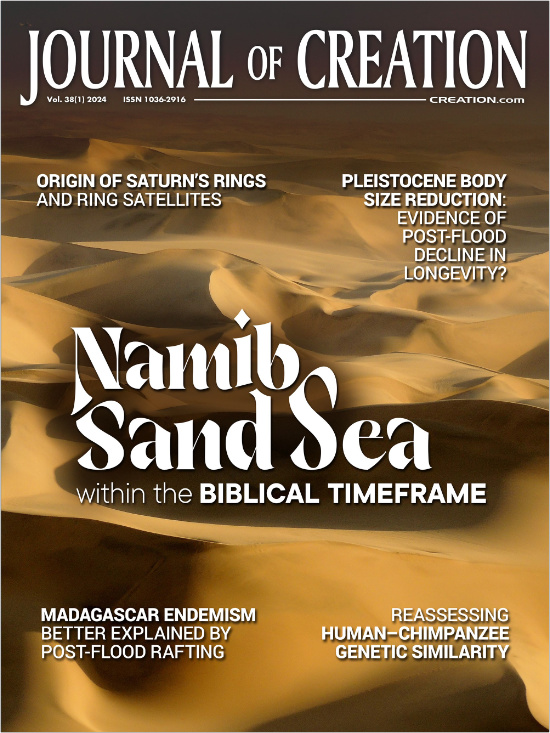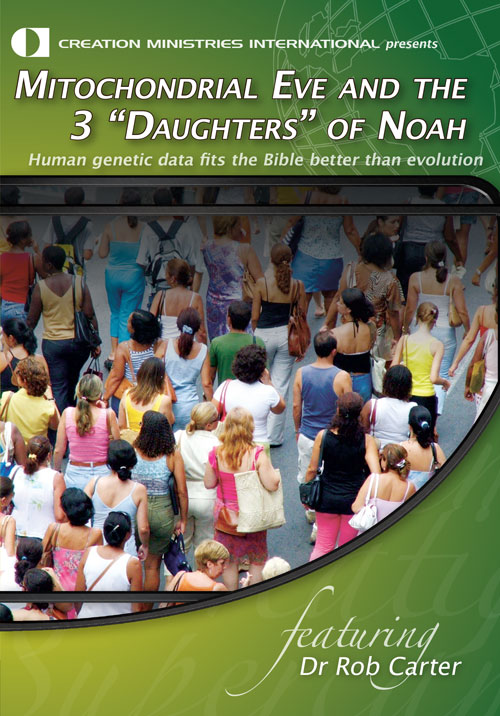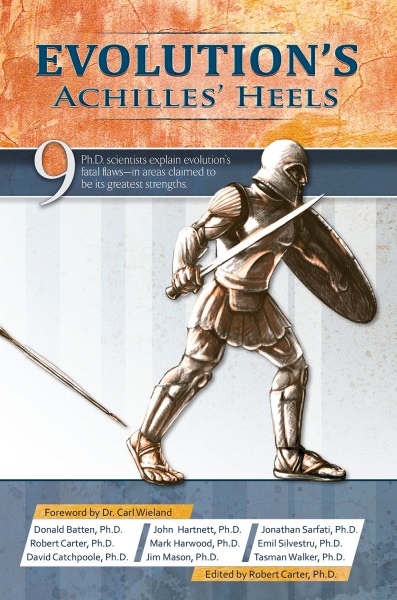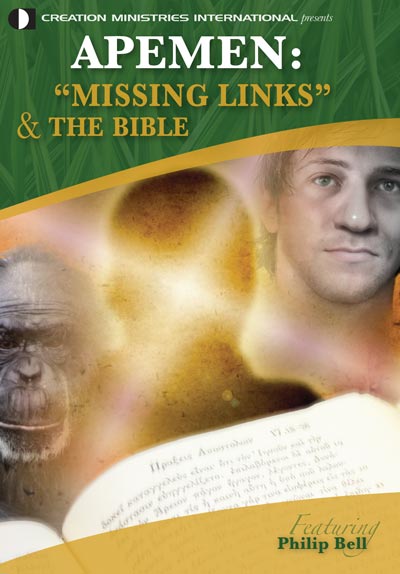Journal of Creation 38(1):3–6, April 2024
Browse our latest digital issue Subscribe
Highlights from review of genetic research on the Denisovans
In 2008, a scrap of human finger bone was discovered in Denisova Cave, an isolated cave in the Altai mountains of southern Siberia, and its mitochondrial DNA (mtDNA) was sequenced in 2010.1 The mtDNA analysis of the finger bone (Denisova 3—a proximal fragment of a juvenile manual distal phalanx; see figure 1), allegedly from a layer dated to between 48 and 30 ka ago, reported that Neanderthals and Denisovans differed from modern humans at an average of 202 and 385 nucleotide positions, respectively.2 From this it was concluded that an “extinct species of human ancestor” had existed in Asia about 40 ka ago, and it was said to be the first time a ‘hominin’ had “been described, not from the morphology of its fossilized bones, but from the sequence of its DNA.”3 The layer that Denisova 3 was found in was later dated to allegedly 63–55 ka.4
Additional bone fragments found
A review paper on the Denisovans was published by me on 28 June 2019, from a non-evolutionary viewpoint.5 At that time there were seven fragmentary remains attributed to Denisovans. Six fragments were from the Denisova Cave, while one (the Xiahe mandible) was from Baishiya Karst Cave, Xiahe county, China. Soon after this review, on 4 September 2019, it was reported by Bennett et al., using ancient DNA analysis, that a distal fragment of a fifth finger (little finger) phalanx from Denisova Cave was the larger, missing part of the fifth finger Denisova 3 proximal fragment of the distal phalanx.6 Concerning this fragment, the authors stated: “Our morphometric analysis shows that its dimensions and shape are within the variability of Homo sapiens and distinct from the Neanderthal fifth finger phalanges.”6
More recently, a comprehensive review by Peyrégne et al., in Nature Reviews Genetics, collated genetic research on the Denisovans, albeit from an evolutionary perspective.7 Three undiagnostic bone fragments (Denisova 19, 20, and 21, all from Denisova Cave) had been added to the Denisova sample by the time of this review, bringing the total to ten fragmentary remains, all attributed to Denisovans based solely on molecular information.8 Denisova 19, 20, and 21 are said to be the oldest of the Denisovan bone fragments, allegedly dated at 217–187 ka, with the youngest being Denisova 3 (genetically dated at 76–52 ka).9 In their discussion of Denisovan population history, Peyrégne et al. also mentioned that the earliest evidence of Denisovan presence is supposedly 250–170 ka ago,9 based on analysis of DNA (by Zavala et al.) in the sediment of Denisova Cave. Zavala et al. also reported finding evidence that Denisovans and Neanderthals occupied the site (Denisova Cave) repeatedly, “possibly until, or after, the onset of the Initial Upper Palaeolithic at least 45,000 years ago, when modern human mtDNA is first recorded in the sediments.”10 The Zavala et al. study was discussed by me earlier, including the dating methods used, with their associated unreliability and problems.11 Similarly, the ages presented in this article are unreliable, being based on many unknowns and flawed assumptions, and so are not accepted here, but are given for the reader’s information.
Denisovan candidates
Peyrégne et al. named ‘archaic’ remains in Asia that may be Denisovan (Narmada in India, Tam Ngu Hao 2-1 in Laos, Penghu 1 from the Taiwan Strait, and Xuchang 1, Xuchang 2, Maba, Xujiayao, Harbin, and Jinniushan in China), based on morphology or geographical and temporal origin, although molecular information to confirm this is lacking.9 According to evolutionists Cartmill and Smith, the Ngandong ‘hominins’ from Java, Indonesia, are also candidate Denisovans.12 The Ngandong (‘Solo Man’) remains are usually classified as Homo erectus. Peyrégne et al. reported that the Denisovan population size likely remained small throughout most of their history, that they seem to have lived in groups of 100 or more individuals, and that when comparing genomes there was evidence “suggesting that inbreeding was not as prevalent in the population of Denisova 3 as it was in Neandertals”.13 The sequence divergence between the genomes of Denisovans and Neanderthals is said to indicate that they were separated for allegedly at least 300,000 years, although genetic evidence also suggested there was subsequent admixture.13
Denisovan ancestry in present populations
The Denisovan genome is said to be unexpectedly divergent to Neanderthals and modern humans in some regions, supporting a superarchaic ancestry presence in the Denisovan genome.14 The levels of Denisovan ancestry in present populations vary widely, with the highest levels being in Philippine Negritos, who have “30–40% more Denisovan ancestry than Melanesians and Indigenous Australians (~4%)”.14 Denisovan introgression into the ancestors of indigenous Australians and Melanesians has been estimated at allegedly between 54 ka and 44 ka ago, with it also estimated that a “Denisovan-related” population perhaps persisted until supposedly 25 ka in Oceania.15 According to Peyrégne et al.:
“The presence of Homo floresiensis close to the time when modern humans reached this region of the world around 46 ka … raises the possibility that they may have met and mixed, and that Homo floresiensis could be related to the population that contributed the highly diverged Denisovan component in present-day Oceanians. There is, however, no evidence of an excess of Denisovan or archaic ancestry among Indigenous populations from Flores … .”16
Denisovans and Homo floresiensis
Although the pygmy population on Flores Island possessed ancestry from both Denisovans and Neanderthals in their genomes, Tucci et al. reported that:
“We found no evidence that unknown sequences in Flores are enriched for older or more divergent lineages … , as would be expected if they contained lineages inherited from a more deeply divergent hominin group, such as H. floresiensis or H. erectus.”17
However, the DNA from H. floresiensis and Homo erectus is currently unknown. Maybe the reason why there is no trace of H. floresiensis or H. erectus in the genomes of the population from Flores is that some of the specimens classified as H. erectus and Homo heidelbergensis were Denisovans. The Denisovans appear to have been a diverse group. Because of the “divergent Denisovan ancestry in present-day populations and their large inferred geographical range”, Peyrégne et al. stated that “it is plausible that there was substantial morphological variability among Denisovans.”18 According to Jacobs et al., there were three Denisovan groups:
“The genetic diversity within the Denisovan clade is consistent with their deep divergence and separation into at least three geographically disparate branches, with one contributing an introgression signal in Oceania and to a lesser extent across Asia (D2), another apparently restricted to New Guinea and nearby islands (D1), and a third in East Asia and Siberia (D0).”19
It may be that the LB1 H. floresiensis specimen was a pathological Denisovan (e.g., a pathological H. erectus), or the pathological offspring of interbreeding between a Denisovan and a ‘modern’ human. Because the effective population size of Denisovans was believed to be small, Peyrégne et al. suggested genetic drift may have resulted in “rapid and random changes in the phenotypic diversity of Denisovan populations”, resulting in Denisovan phenotypes that “could have differed greatly between populations.”18 Peyrégne et al. commented that Homo luzonensis, from the Philippines, may have been related to Denisovans, but that it was not possible to link them without ancient DNA or proteins.20 Peyrégne et al. also listed some of the many challenges in detecting Denisovan ancestry in the genomes of present-day people, including:
“The panel of archaic reference genomes is small, particularly for Denisovans where there is only a single Denisovan reference genome (Denisova 3) compared with three Neanderthal genomes (Denisova 5, Vindija 33.19 and Chagyrskaya 8). This limited view of the genetic variation among archaic humans complicates comprehensive identification of introgressed archaic segments by limiting the number of known informative variants and their frequency in archaic humans.”20
Denisovan phenotype
According to Peyrégne et al., differences in gene expression are believed “to account for most phenotypic changes in human evolution”, and these involve non-coding sequences, the effect on gene expression (including the Denisovan phenotype) of which is hard to predict.21 Of course, differences in gene expression do not require an evolutionary explanation. Rather, it can be inbuilt genetic variation (or the inbuilt potential for gene expression to vary) put there by the Creator. This could involve epigenetic modifications, such as differentially methylated regions between different human groups. In discussing this, Peyrégne et al. stated that:
“Further description of these differentially methylated regions between modern and archaic humans highlighted anatomical phenotypes that Denisovans may have shared with Neanderthals, including a robust jaw, a low cranium, an increased cranial base growth, a low forehead, a thick enamel, a wide pelvis, large femoral articulations, wide fingertips and a large ribcage … .”21
However, more Denisovan fossils need to be identified to test the accuracy of phenotypic predictions like the above. It is interesting that the fragment of Denisovan parietal bone found was described as “surprisingly thick, more like cranial bones of Stone Age Homo erectus”.22 The Xiahe mandible (figure 2, identified as Denisovan by ancient protein analysis), which has no chin, was described by paleoanthropologist Roberto Sáez:
“The mandibular morphology in general is primitive, short and very robust, and close to Homo erectus specimens. But the less elongated shape of the dental arcade is closer to that of the earliest Middle Pleistocene specimens of Neanderthals and Homo sapiens. The teeth are similar to the Denisovans’ from Altai mountains, and their morphology fits within Middle Pleistocene hominin variability [emphases in original].”23
While one cannot yet say with certainty that the Denisovans included Homo erectus specimens, indications are that they were erectus-like, and whether you call them Homo erectus or Homo heidelbergensis (Middle Pleistocene hominins) is, in many ways, a moot point, as there appears to be little difference between them.
Comparing genomes
Although also having limitations, phenotypic inferences from Denisovan ancestry in present-day genomes is used to indirectly investigate the Denisovan phenotype. An example is a version of the EPAS1 gene, inherited by Tibetans, “involved in the physiological response to low concentrations of oxygen at high altitudes”.24 Towards the end of their review paper, Peyrégne et al. have a section titled “Insights into modern human evolution from archaic genomes”. Here they state:
“Comparing the genomes of many thousands of present-day humans with those of Neanderthals and Denisovans has identified about 30,000 single nucleotide changes, 4,000 small insertions or deletions (indels) and a few copy number differences that all, or nearly all, present-day humans carry, whereas archaic humans carry the ancestral state shared with great apes … .”25
However, combining “all, or nearly all” means not all nucleotide changes are fixed, rather some are near-fixation. According to Kuhlwilm and Boeckx:
“Previously, a number of 31,389 sites has been reported as recently fixed derived in present-day humans, while being ancestral in archaics … . We find a smaller number of only 12,027 positions in the genome, in part due to the inclusion of another archaic individual and different filters, but mainly because of a richer picture of present-day human variation. The 1,000 Genomes Project as well as other sources contributing to the dbSNP database now provide data for thousands of individuals, which results in very high allele frequencies for many loci, instead of full fixation. Indeed, 29,358 positions show allele frequencies larger than 0.995, demonstrating that the level of near-fixation is similar to the level of previously presented fixation. The number of loci with high frequency (HF) changes of more than 90% in present-day humans is an order of magnitude larger than the number of fixed differences. This cutoff is somewhat arbitrary and based on previous work … . However, when increasing the frequency cutoff, the number declines sharply, while decreasing it results in a near-linear increase of sites.”26
Hence, if you only include genetic changes that are fixed in present-day humans, then the number of changes compared to ‘archaic’ humans will be reduced, perhaps considerably (depending on the HF cutoff associated with near-fixation), compared to also including near-fixation changes in present-day humans. Even what was considered fixed may not be if it does not account for the “richer picture of present-day human variation”. And even then, comparing the genomes of thousands of present-day humans to three ‘archaic’ humans (two Neanderthals and one Denisovan, as in the above study by Kuhlwilm and Boeckx27) is unlikely to account for the genetic variation in the latter. As stated by Kuhlwilm and Boeckx:
“The three archaic individuals carry more than twice as many changes than present-day humans; however, we emphasize that much of this difference is not due to more mutations in archaics, but rather the fact that data for only three individuals is available, compared to thousands of humans. The variation across the archaic population is not represented equally well, which makes these numbers not directly comparable.”26
The above genetic differences between present-day humans and ‘archaic’ humans are trivial compared to the differences in the genomes between present-day humans and chimpanzees (chimps). The assertion that human and chimp DNA are 98 to 99% similar is not accurate. Even if it was true, a 99% similarity would be equal to 30 million single nucleotide base pair differences. Even with the false idea of just 1% difference, a transition from chimp to human is impossible for mutations to achieve in the time available.28 As the paper by Carter in this journal shows, however, it is likely that the difference is around 95%.29 If so, compared to the problem described above for the 99% claim, it worsens the problem for neo-Darwinian evolution five-fold. It requires an additional 120 million base pair differences to become fixed in the population through mutation and selection.
In their conclusion, Peyrégne et al. reported that evidence gathered on the Denisovans to date included a history of “numerous episodes of interbreeding with Neanderthals, as well as with modern humans, and possibly other ancient human groups.”30 However, they acknowledge that questions about the Denisovans still remain unanswered, in particular that little is known of their appearance.31
References and notes
- Dalton, R., Fossil finger points to new human species, Nature 464:472–473, 2010. Return to text.
- Krause, J., Fu, Q., Good, J.M. et al., The complete mitochondrial DNA genome of an unknown hominin from southern Siberia, Nature 464:894–895, 2010. See also supplementary information, p. 1, for description of manual phalanx. Return to text.
- Brown, T.A., Stranger from Siberia, Nature 464:838, 2010. Return to text.
- Jacobs, Z., Li, B., Shunkov, M.V. et al., Timing of archaic hominin occupation of Denisova Cave in southern Siberia, Nature 565:597, 2019. Return to text.
- Line, P., An overview of the Denisovan puzzle, creation.com, 28 Jun 2019. Return to text.
- Bennett, E.A., Crevecoeur, I., Viola, B. et al., Morphology of the Denisovan phalanx closer to modern humans than to Neanderthals, Science Advances 5(9):eaaw3950:1, 4 Sep2019 ǀ doi:10.1126/sciadv.aaw3950. Return to text.
- Peyrégne, S, Slon, V.’ and Kelso, J., More than a decade of genetic research on the Denisovans, Nature Reviews Genetics, 18 Sep 2023 ǀ doi:10.1038/s41576-023-00643-4. Return to text.
- Peyrégne et al., ref. 7, pp. 1, 8. Return to text.
- Peyrégne et al., ref. 7, p. 2. Return to text.
- Zavala, E.I., Jacobs, Z., Vernot, B. et al., Pleistocene sediment DNA reveals hominin and faunal turnovers at Denisova Cave, Nature 595:399, 2021 ǀ doi:10.1038/s41586-021-03675-0. Return to text.
- Line, P., Analysis of mtDNA from sediments in Denisova Cave, J. Creation 35(3):5–7, 2021. Return to text.
- Cartmill, M. and Smith, F.H., The Human Lineage, 2nd edn, John Wiley & Sons, Inc., Hoboken, NJ, p. 382, 2022. Return to text.
- Peyrégne et al., ref. 7, p. 3. Return to text.
- Peyrégne et al., ref. 7, p. 5. Return to text.
- Peyrégne et al., ref. 7, pp. 8–9. Return to text.
- Peyrégne et al., ref. 7, pp. 11–12. Return to text.
- Tucci, S., Vohr, S.H., McCoy, R.C., et al., Evolutionary history and adaptation of a human pygmy population of Flores Island, Indonesia, Science 361:512, 515, 2018 ǀ doi:10.1126/science.aar8486. Return to text.
- Peyrégne et al., ref. 7, p. 13. Return to text.
- Jacobs, G.S., Hudjashov, G., Saag, L. et al., Multiple deeply divergent Denisovan ancestries in Papuans, Cell 177:9, 2019 ǀ doi:10.1016/j.cell.2019.02.035. Return to text.
- Peyrégne et al., ref. 7, p. 12. Return to text.
- Peyrégne et al., ref. 7, p. 14. Return to text.
- Bower, B., First known fossil of a Denisovan skull discovered in cave, 29 Mar 2019. Return to text.
- Sáez, R., Finally, the mandible of a Denisovan! – Nutcracker Man, 1 May 2019. Return to text.
- Peyrégne et al., ref. 7, p. 15. Return to text.
- Peyrégne et al., ref. 7, p. 16. Return to text.
- Kuhlwilm, M and Boeckx, C., A catalog of single nucleotide changes distinguishing modern humans from archaic hominins, Scientific Reports 9:8463, p. 3, 11 Jun 2019 ǀ doi:10.1038/s41598-019-44877-x. Return to text.
- Kuhlwilm and Boeckx, ref. 26, p. 9. Return to text.
- Line, P., The myth of ape-to-human evolution, Creation 41(1):44–46, 2019. Return to text.
- Carter, R.W., Reassessing human–chimpanzee genetic similarity, J. Creation 38(1):93–103, 2024. Return to text.
- Peyrégne et al., ref. 7, p. 17. Return to text.
- Peyrégne et al., ref. 7, pp. 17–18. Return to text.







Readers’ comments
Comments are automatically closed 14 days after publication.